
(ryanphotographic.com)
Phylum: Chordata Haeckel, 1874
Subphylum: VertebrataLamarck J-B., 1801
Classe: Actinopterygii Klein, 1885
Ordine: Perciformes Bleeker, 1859
Famiglia: Carangidae Rafinesque, 1815
Genere: Caranx Lacepède, 1801
English: Bluefin trevally
Français: Carangue aîle bleue
Español: Jurel aleta azul
Descrizione
Presenta un corpo dalla forma tipica, allungato, molto compresso ai fianchi, con testa e bocca grandi, alto profilo dorsale e ventrale, coda fortemente bilobata. Le pinne pettorali sono a foggia di falce, pinna dorsale e anale sono opposte e simmetriche. La livrea ha fondo azzurro argenteo con riflessi bronzei e finemente chiazzato di azzurro vivo e blu scuro. Le pettorali sono giallo limone, le altre pinne blu elettrico con riflessi azzurro vivo. C. melampygus raggiunge una lunghezza massima accertata di 115 cm, ma la taglia riscontrabile comunemente si attesta sui 60 cm. Questo carangide è un grande predatore e si nutre prevalentemente di altri pesci e di crostacei. C. melampygus è preda abituale di Fistularia commersonii. È apprezzata preda per la pesca sportiva, ma anche pescata e allevata in acquacoltura per l'alimentazione umana. È spesso veicolo dell'intossicazione alimentare ciguatera una volta superata la taglia di 50 cm. È allevato, come altri carangidi, negli acquari pubblici.
Diffusione
Questa specie è diffusa nell'Oceano Indiano, dal Mar Rosso fino all'Isola Ducie, Isole Ryukyu, Nuova Caledonia e nel Pacifico, dal Messico a Panama. Abita acque salate e salmastre, prevalentemente nelle barriere coralline.
Sinonimi
= Carangichthys melampygus Cuvier, 1833 = Carangus melampygus Cuvier, 1833 = Caranx medusicola Jordan & Starks, 1895 = Caranx melampyges Cuvier, 1833 = Caranx stellatus Eydoux & Souleyet, 1850 = Caranx valenciennei Castelnau, 1873 = Carynx melampygus Cuvier, 1833.
Bibliografia
–Smith-Vaniz, W.F. & Williams, I. (2016). "Caranx melampygus (errata version published in 2017)". IUCN Red List of Threatened Species. IUCN. 2016: e.T20430679A115377830.
–Froese, Rainer and Pauly, Daniel, eds. (2019). "Caranx melampygus" in FishBase. August 2019 version.
–J. S. Nelson; T. C. Grande; M. V. H. Wilson (2016). Fishes of the World (5th ed.). Wiley. pp. 380–387. ISBN 978-1-118-34233-6.
–Cuvier, G.; A. Valenciennes (1849). Histoire naturelle des poissons. F.G. Levrault. pp. IX, 93.
–Hosese, D.F.; Bray, D.J.; Paxton, J.R.; Alen, G.R. (2007). Zoological Catalogue of Australia Vol. 35 (2) Fishes. Sydney: CSIRO. p. 1150. ISBN 978-0-643-09334-8.
–California Academy of Sciences: Ichthyology (September 2009). "Caranx melampygus". Catalog of Fishes. CAS. Retrieved 2009-09-16.
–Berry, F.H. (1965). "The spotted jack crevalle, Caranx melampygus Cuvier, in the Eastern Pacific". California Fish and Game. 51 (1): 28-36.
–Smith-Vaniz, W. (1999). "Carangidae" (PDF). In Carpenter, K.E.; Niem, V.H. (eds.). The living marine resources of the Western Central Pacific Vol 4. Bony fishes part 2 (Mugilidae to Carangidae). FAO species identification guide for fishery purposes. Rome: FAO. pp. 2659-2757. ISBN 92-5-104301-9.
–Fischer, W.; Krupp F.; Schneider W.; Sommer C.; Carpenter K.E.; Niem V.H. (1995). Guía FAO para la identificación de especies para los fines de la pesca. Pacífico centro-oriental. Volumen II. Vertebrados - Parte 1. Rome: FAO. p. 953. ISBN 92-5-303409-2.
–Randall, John E. (1995). Coastal Fishes of Oman. University of Hawaii Press. Honolulu. p. 183. ISBN 0-8248-1808-3.
–Lin, Pai-Lei; Shao, Kwang-Tsao (1999). "A Review of the Carangid Fishes (Family Carangidae) From Taiwan with Descriptions of Four New Records". Zoological Studies. 38 (1): 33-68.
–Allen, G.R.; D.R. Robertson (1994). Fishes of the tropical eastern Pacific. University of Hawaii Press. p. 332. ISBN 978-0-8248-1675-9.
–van der Elst, Rudy; Peter Borchert (1994). A Guide to the Common Sea Fishes of Southern Africa. New Holland Publishers. p. 142. ISBN 1-86825-394-5.
–Hutchins, B.; Swainston, R. (1986). Sea Fishes of Southern Australia: Complete Field Guide for Anglers and Divers. Melbourne: Swainston Publishing. p. 187. ISBN 1-86252-661-3.
–Honebrink, Randy R. (2000). "A review of the biology of the family Carangidae, with emphasis on species found in Hawaiian waters" (PDF). DAR Technical Report. Honolulu: Department of Land and Natural Resources. 20-01: 1-43. Retrieved 2009-05-11.
–Grove, Jack S.; Robert J. Lavenberg (1997). The Fishes of the Galápagos Islands. California: Stanford University Press. p. 376. ISBN 978-0-8047-2289-6.
–Sudekum, A.E.; Parrish, J.D.; Radtke, R.L.; Ralston, S. (1991). "Life History and Ecology of Large Jacks in Undisturbed, Shallow, Oceanic Communities" (PDF). Fishery Bulletin. 89 (3): 493-513. Retrieved 2009-09-14.
–Amesbury, S.A.; Myers, R.F. (1982). Guide to the coastal resources of Guam. Volume 1. University of Guam Press. p. 141.
–Smith, G.C.; Parrish, J.D. (2002). "Estuaries as Nurseries for the Jacks Caranx ignobilis and Caranx melampygus (Carangidae) in Hawaii". Estuarine, Coastal and Shelf Science. 55 (3): 347-359. Bibcode: 2002ECSS...55..347S.
–Unsworth, R.K.F.; Bell, J.J.; Smith, D.J. (2007). "Tidal fish connectivity of reef and sea grass habitats in the Indo-Pacific". Journal of the Marine Biological Association of the UK. 87 (5): 1287–1296.
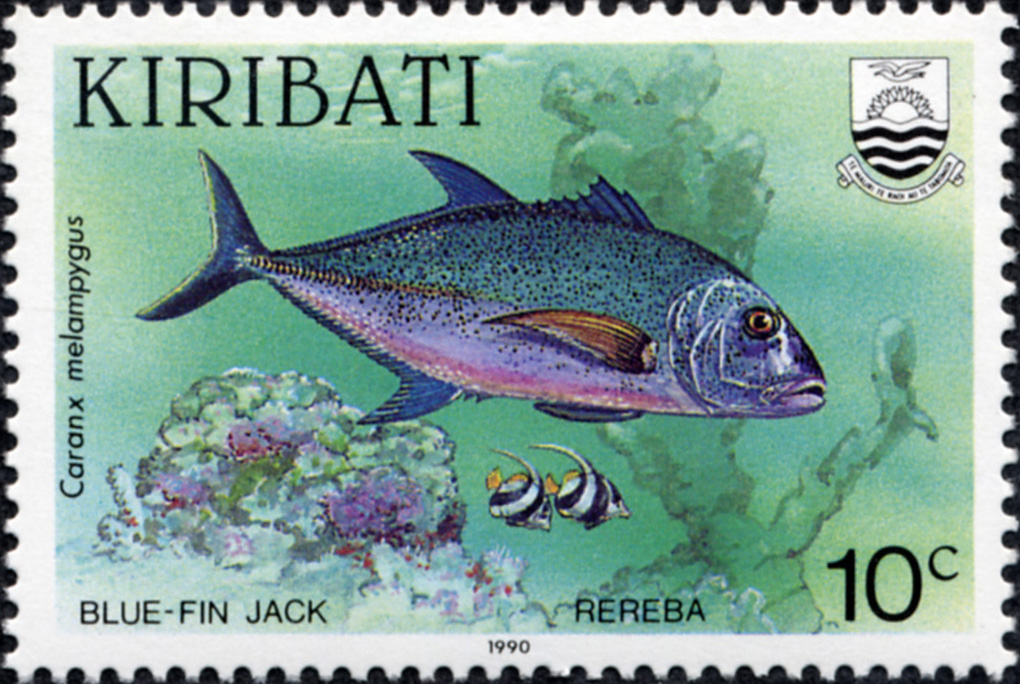
|
Data: 12/07/1990
Emissione: Pesci della barriera corallina di Kirabati Pesci della barriera corallina di Kirabati Stato: Kiribati |
|---|
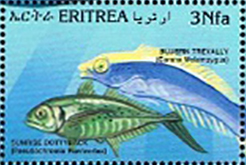
|
Data: 29/12/1997
Emissione: Ricchezza della vita marina Stato: Eritrea Nota: Emesso in un foglietto di 9 v. diversi |
|---|
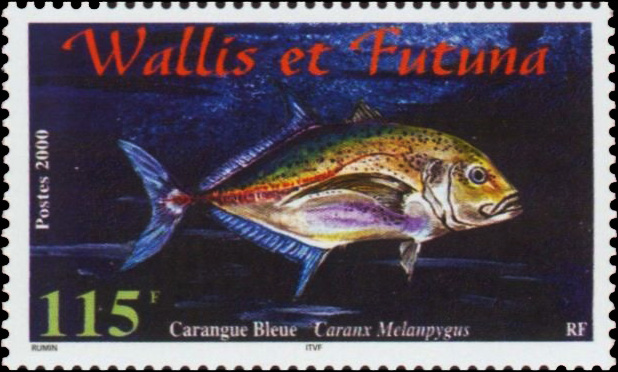
|
Data: 09/11/2000
Emissione: Ittiofauna Stato: Wallis and Futuna Nota: Emesso in una striscia con 2 vignette |
|---|
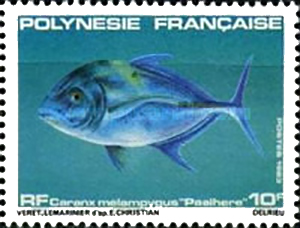
|
Data: 09/02/1983
Emissione: Ittiofauna Stato: French Polynesia |
|---|
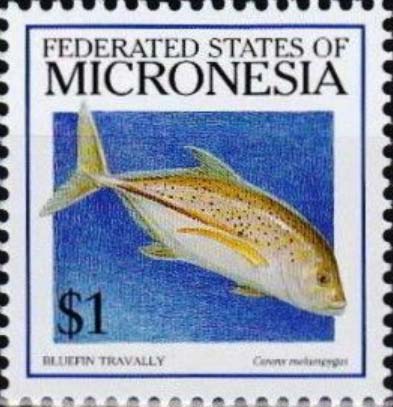
|
Data: 01/01/1998
Emissione: Ittiofauna Stato: Micronesia |
|---|

